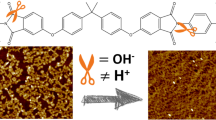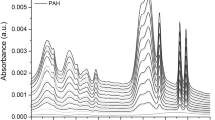Abstract
Currently, atomic force microscopy is the preferred technique to determine roughness on membrane surfaces. In this paper, a new method to measure surface roughness is presented using a 3D laser scanning confocal microscope for high-resolution topographic analysis and is compared to conventional SEM. For this study, the surfaces of eight samples based on a poly(vinylidene fluoride-co-hexafluoropropylene) (PVDF-HFP) host polymer with different liquid interpenetrating components were analyzed. Polymethylhydrosiloxane, triethylene glycolallylmethylether, (3,3,3-trifluoropropyl)methylcyclotrisiloxane (D3-C2H4CF3), polysiloxane-comb-propyloxymethoxytriglycol (PSx), polysiloxane-comb-propyl-3,3,3-trifluoro (PSx-C2H4CF3), poly[bis(2-(2-methoxyethoxy) ethoxy) phosphazene, or poly[bis(trifluoro)ethoxy] phosphazene was chosen as interpenetrating compound to investigate the impact of comb and double-comb-structured polymer backbones, as well as their dipolar or fluorous residues on the PVDF-HFP-miscibility. Different phases of the constituting ingredients were identified via their thermal properties determined by DSC. Additionally, the COSMO-RS method supported the experimental results, and with regard to computed σ-profiles, new modified structures for polysiloxane and polyphosphazene synthesis were suggested.










Similar content being viewed by others
References
Souquet, JL, Duclot, M, “Thin Film Lithium Batteries.” Solid State Ion, 148 375–379 (2002)
Seo, I, Steve, W, New Developments in Solid Electrolytes for Thin-Film Lithium Batteries, In: Belharouak, I (ed.) Lithium Ion Batteries—New Developments, InTech, New York, 2012. http://www.intechopen.com/books/lithium-ion-batteries-new-developments/new-developments-in-solid-electrolytes-for-thin-film-lithium-batteries
Xia, H, Wang, HL, Xiao, W, Lai, MO, Lu, L, “Thin Film Li Electrolytes for All-Solid-State Micro-batteries.” Int. J. Surf. Sci. Eng., 3 23 (2009)
Bates, JB, Dudney, NJ, Neudecker, B, Ueda, A, Evans, CD, “Thin-Film Lithium and Lithium-Ion Batteries.” Solid State Ion., 135 33–45 (2000)
Gaikwad, AM, Arias, AC, Steingart, DA, “Recent Progress on Printed Flexible Batteries: Mechanical Challenges, Printing Technologies, and Future Prospects.” Energy Technol., 3 305–328 (2015)
Oudenhoven, JFM, Baggetto, L, Notten, PHL, “All-Solid-State Lithium-Ion Microbatteries: A Review of Various Three-Dimensional Concepts.” Adv. Energy Mater., 1 10–33 (2011)
Patil, A, et al., “Issue and Challenges Facing Rechargeable Thin Film Lithium Batteries.” Mater. Res. Bull., 43 1913–1942 (2008)
Seidel, SM, Jeschke, S, Vettikuzha, P, Wiemhöfer, H-D, “PVDF-HFP/Ether-Modified Polysiloxane Membranes Obtained via Airbrush Spraying as Active Separators for Application in Lithium Ion Batteries.” Chem. Commun., 51 12048–12051 (2015)
Gowda, SR, et al., “Conformal Coating of Thin Polymer Electrolyte Layer on Nanostructured Electrode Materials for Three-Dimensional Battery Applications.” Nano Lett., 11 101–106 (2011)
Lee, H, Lee, DJ, Kim, Y-J, Park, J-K, Kim, H-T, “A Simple Composite Protective Layer Coating that Enhances the Cycling Stability of Lithium Metal Batteries.” J. Power Sources, 284 103–108 (2015)
Sham, AYW, Notley, SM, “Graphene–Polyelectrolyte Multilayer Film Formation Driven by Hydrogen Bonding.” J. Colloid Interface Sci., 456 32–41 (2015)
Jung, Y-C, Lee, S-M, Choi, J-H, Jang, SS, Kim, D-W, “All Solid-State Lithium Batteries Assembled with Hybrid Solid Electrolytes.” J. Electrochem. Soc., 162 A704–A710 (2015)
Zhang, H, et al., “Lithium Bis(fluorosulfonyl)imide/Poly(ethylene oxide) Polymer Electrolyte.” Electrochim. Acta, 133 529–538 (2014)
Chun-Guey, W, Chiung-Hui, W, Ming-I, L, Huey-Jan, C, “New Solid Polymer Electrolytes Based on PEO/PAN Hybrids.” J. Appl. Polym. Sci., 99 1530–1540 (2006)
Kesavan, K, Rajendran, S, Mathew, CM, “Studies on Poly(vinyl pyrrolidone) Based Solid Polymer Blend Electrolytes Complexed with Various Lithium Salts.” Polym. Sci. Ser. B, 56 520–529 (2014)
Cznotka, E, Jeschke, S, Vettikuzha, P, Wiemhöfer, H-D, “Semi-interpenetrating Polymer Network of Poly(methyl methacrylate) and Ether-Modified Polysiloxane.” Solid State Ion., 274 55–63 (2015)
Chung, N, Kang, D, Kim, D, “Preparation and Properties of Cross-linked Poly(ethylene glycol)/Poly[(vinylidene fluoride)-co-hexafluoropropylene] Interpenetrating Network-Type Electrolytes for Secondary Lithium Batteries.” Polym. Int., 54 1153–1157 (2005)
Fan, L, Dang, Z, Nan, C-W, Li, M, “Thermal, Electrical and Mechanical Properties of Plasticized Polymer Electrolytes Based on PEO/P(VDF-HFP) Blends.” Electrochim. Acta, 48 205–209 (2002)
Ren, Z, et al., “Polymer Electrolytes Based on Poly(vinylidene fluoride-co-hexafluoropropylene) with Crosslinked Poly(ethylene glycol) for Lithium Batteries.” Solid State Ion., 180 693–697 (2009)
Li, H, et al., “Gel Polymer Electrolytes Based on Active PVDF Separator for Lithium Ion Battery. I: Preparation and Property of PVDF/Poly(dimethylsiloxane) Blending Membrane.” J. Membr. Sci., 379 397–402 (2011)
Li, H, et al., “Preparation and Properties of Poly(vinylidene fluoride)/Poly(dimethylsiloxane) Graft (Poly(propylene oxide)-block-Poly(ethylene oxide)) Blend Porous Separators and Corresponding Electrolytes.” Electrochim. Acta, 116 413–420 (2014)
Liu, F, Hashim, NA, Liu, Y, Abed, MRM, Li, K, “Progress in the Production and Modification of PVDF Membranes.” J. Membr. Sci., 375 1–27 (2011)
Cznotka, E, Jeschke, S, Wiemhöfer, H-D, “Characterization of Semi-interpenetrating Polymer Electrolytes Containing Poly(vinylidene fluoride-co-hexafluoropropylene) and Ether-Modified Polysiloxane.” J. Membr. Sci. (submitted)
Tang, S, Zhao, H, “Glymes as Versatile Solvents for Chemical Reactions and Processes: From the Laboratory to Industry.” RSC Adv., 4 11251 (2014)
Gladysz, J, Curran, DP, “Fluorous Chemistry: From Biphasic Catalysis to a Parallel Chemical Universe and Beyond.” Tetrahedron, 58 3823–3825 (2002)
Hooper, R, et al., “Highly Conductive Siloxane Polymers.” Macromolecules, 34 931–936 (2001)
Bufton, JL, “Laser Altimetry Measurements from Aircraft and Spacecraft.” Proc. IEEE, 77 463–477 (1989)
Fifer-Bizjak, K, “Determining the Surface Roughness Coefficient by 3D Scanner.” Geologija, 53 147–152 (2010)
Kukko, A, Anttila, K, Manninen, T, Kaasalainen, S, Kaartinen, H, “Snow Surface Roughness from Mobile Laser Scanning Data.” Cold Reg. Sci. Technol., 96 23–35 (2013)
Siewczyńska, M, “Method for Determining the Parameters of Surface Roughness by Usage of a 3D Scanner.” Arch. Civ. Mech. Eng., 12 83–89 (2012)
Klamt, A, “The COSMO and COSMO-RS Solvation Models.” Wiley Interdiscip. Rev. Comput. Mol. Sci., 1 699–709 (2011)
Klamt, A, “COSMO-RS for Aqueous Solvation and Interfaces.” Fluid Phase Equilib., (2015). doi:10.1016/j.fluid.2015.05.027
Klamt, A, Jonas, V, Bürger, T, Lohrenz, JCW, “Refinement and Parametrization of COSMO-RS.” J. Phys. Chem. A, 102 5074–5085 (1998)
Jankowsky, S, Hiller, MM, Wiemhöfer, H-D, “Preparation and Electrochemical Performance of Polyphosphazene Based Salt-in-Polymer Electrolyte Membranes for Lithium Ion Batteries.” J. Power Sources, 253 256–262 (2014)
Allcock, HR, Nelson, JM, Reeves, SD, Honeyman, CH, Manners, I, “Ambient-Temperature Direct Synthesis of Poly(organophosphazenes) via the ‘Living’ Cationic Polymerization of Organo-Substituted Phosphoranimines.” Macromolecules, 30 50–56 (1997)
Allcock, HR, Krause, WE, “Polyphosphazenes with Adamantyl Side Groups.” Macromolecules, 30 5683–5687 (1997)
Li, M, et al., “Controlling the Microstructure of Poly(vinylidene-fluoride) (PVDF) Thin Films for Microelectronics.” J. Mater. Chem. C, 1 7695–7702 (2013)
Stewart, JJP, “MOPAC: A Semiempirical Molecular Orbital Program.” J. Comput. Aided Mol. Des., 4, 1–103 (1990)
Maia, JDC, et al., “GPU Linear Algebra Libraries and GPGPU Programming for Accelerating MOPAC Semiempirical Quantum Chemistry Calculations.” J. Chem. Theory Comput., 8 3072–3081 (2012)
Stewart, JJP, “Optimization of Parameters for Semiempirical Methods VI: More Modifications to the NDDO Approximations and Re-optimization of Parameters.” J. Mol. Model., 19 1–32 (2013)
Allouche, A-R, “Gabedit—A Graphical User Interface for Computational Chemistry Softwares.” J. Comput. Chem., 32 174–182 (2011)
TURBOMOLE, University of Karlsruhe and Forschungszentrum Karlsruhe GmbH, 2007
Ahlrichs, R, Bär, M, Häser, M, Horn, H, Kölmel, C, “Electronic Structure Calculations on Workstation Computers: The Program System Turbomole.” Chem. Phys. Lett., 162 165–169 (1989)
Becke, AD, “Density-Functional Exchange-Energy Approximation with Correct Asymptotic Behavior.” Phys. Rev. A, 38 3098–3100 (1988)
Perdew, JP, “Density-Functional Approximation for the Correlation Energy of the Inhomogeneous Electron Gas.” Phys. Rev. B, 33 8822–8824 (1986)
Schäfer, A, Huber, C, Ahlrichs, R, “Fully Optimized Contracted Gaussian Basis Sets of Triple Zeta Valence Quality for Atoms Li to Kr.” J. Chem. Phys., 100 5829 (1994)
Loschen, C, Klamt, A, “Prediction of Solubilities and Partition Coefficients in Polymers Using COSMO-RS.” Ind. Eng. Chem. Res., 53 11478–11487 (2014)
Fox, TG, Flory, PJ, “Second-Order Transition Temperatures and Related Properties of Polystyrene. I. Influence of Molecular Weight.” J. Appl. Phys., 21 581 (1950)
Bharti, A, Banerjee, T, “Solubility Prediction of Bio-oil Derived Chemicals in Aqueous Media by Localized Molecular Orbital-Energy Decomposition Analysis (LMO-EDA) and COSMO-RS predictions.” Comput. Theor. Chem., 1067 48–59 (2015)
Garcia-Chavez, LY, Hermans, AJ, Schuur, B, de Haan, AB, “COSMO-RS Assisted Solvent Screening for Liquid–Liquid Extraction of Mono Ethylene Glycol from Aqueous Streams.” Sep. Purif. Technol., 97 2–10 (2012)
Klamt, A, Eckert, F, “COSMO-RS: A Novel and Efficient Method for the A Priori Prediction of Thermophysical Data of Liquids.” Fluid Phase Equilib., 172 43–72 (2000)
Hallinan, DT, Balsara, NP, “Polymer Electrolytes.” Annu. Rev. Mater. Res., 43 503–525 (2013)
Meyer, WH, “Polymer Electrolytes for Lithium-Ion Batteries.” Adv. Mater. Deerfield Beach Fla, 10 439–448 (1998)
Acknowledgments
The authors want to thank Hendrik Rönnfeldt and Kai Meine from KEYENCE Microscope Europe for technical support and assistance referring to the 3D laser scanning confocal microscopy. This work was financially supported within BMBF grant 13N13240.
Author information
Authors and Affiliations
Corresponding author
Additional information
Eva Cznotka and Steffen Jeschke have contributed equally to this work.
This paper was presented at the 11th Coatings Science International Conference (COSI) on June 22–26, 2015 in Noordwijk, the Netherlands.
Rights and permissions
About this article
Cite this article
Cznotka, E., Jeschke, S., Schmohl, S. et al. 3D laser scanning confocal microscopy of siloxane-based comb and double-comb polymers in PVDF-HFP thin films. J Coat Technol Res 13, 577–587 (2016). https://doi.org/10.1007/s11998-015-9754-4
Published:
Issue Date:
DOI: https://doi.org/10.1007/s11998-015-9754-4




